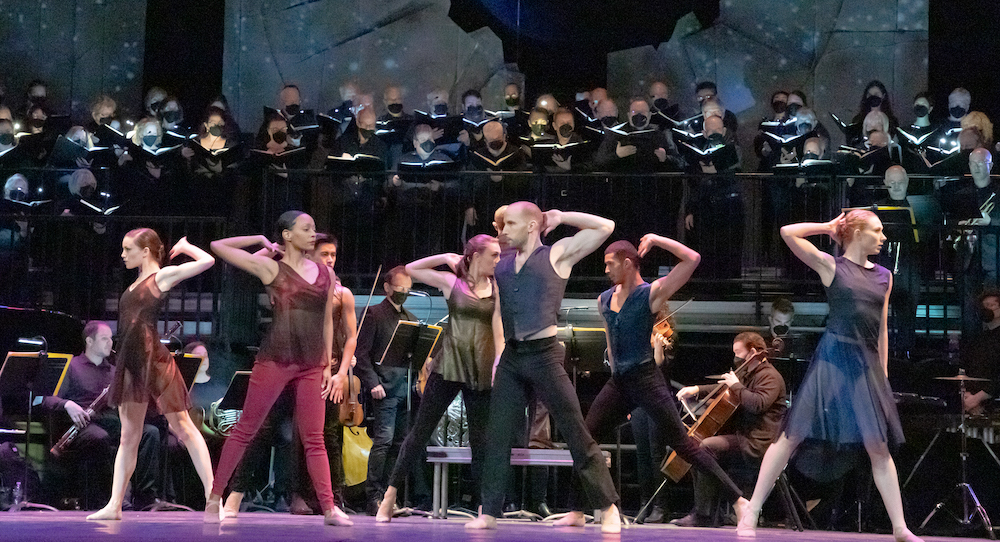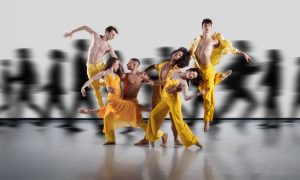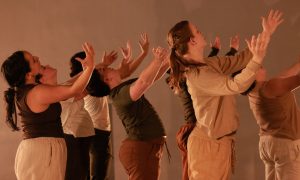Veterans Memorial Theater, Providence, RI.
March 11, 2022.
Booming music and soulful dance resonating into your flesh and bones: there’s nothing quite like it. It can envelop and overcome you. This is spectacle. That word can have a negative connotation (over the top, cheap, saccharine) – but spectacle can be measured and wise, thoughtfully constructed and presented. This was the sort of thoughtful extravaganza that Island Moving Company (IMC) presented for its 40th Anniversary Gala Masterful Movers.
Forty years of creating and sharing art is certainly something to celebrate, and a spectacle of excellence is a great way to do so. That’s also perhaps just what we all need right now: something beautiful, something earnest, something uniting. Nicolo Fonte’s Where we left off and a modern re-imagining of Carl Orff’s Carmina Burana (from IMC Artistic Director Miki Ohlsen, IMC Associate Artistic Director Danielle Genest and Dr. Joshua D. Rhode) made up this celebratory program.
Fonte’s work (with Tom Mossbrucker contributing staging) shot the program out of a cannon: dynamic, exciting, filled with multiplicity of possibility. At the same, threads of repeated movement and ways in which the dancers related ran through the work. These were undercurrents that kept a baseline for connecting and understanding.
The work began with one dancer, and then one by one more joined: an accumulation and evolution that laid a foundation for what was to come. After the ensemble of 10 had accumulated, the dancers shifted into a vivacious group section. The movement hit a challenging trifecta: fast, detailed and technical. Impressively, the dancers met that trifecta challenge with an embodiment of ease and integration. They even seemed to luxuriate in it.
The ensemble also danced with size but also enticing refinement (in no way easy to do). Shifting facings in space and unconventional pathways through the body made it anyone’s guess what choices could come next, but I wanted to find out. Clear geometry of shape – lines, arcing pathways, clear facings – met serpentine moments to create dynamic contrast and full possibility. That all created movement that was a treat to experience.
In another compelling duality, dancers diverged and converged: swooping toward and away, together and apart in the stage space. These choices illustrated the dance of human connection, the ways in which we meet and miss one another. “Where we left off,” indeed – where we found one another last and how we keep reaching to find that place again.
Enhancing that effect was how the dancers seemed to almost glow against a much darker backdrop, the lighting (from Seah Jonson) shining on pearly white costumes (from Mark Zappone, courtesy of Aspen Sante Fe Ballet). I conjectured that lighting from the wings helped to create that effect (a little realism behind the magic), but it spoke to me of the vibrancy of a soul – how we all bring our own energy to whatever environment we move through, bright or dark.
After that vigorous ensemble section, the work shifted into quieter, yet still lively smaller solos, duets, and trios, and small groups (short of the full ensemble). The performers demonstrated true unspoken understanding, in and through each other’s bodies, as they executed (what seemed to me like) quite challenging lifts, shapes, and pathways through the stage space. They also illustrated a vital “less is more” understanding within these quieter moments: giving 150 percent to the work, but also letting it speak for itself and be all that it is. Sometimes, no more is necessary.
Memorably beautiful choreography met that command and commitment from the performers to let something deeper shine through: that dance of human interaction, meeting and missing each other, in myriad ways and with myriad people we come across in life. Little chapters of interaction, with those various groupings, cohered to tell such a bigger story.
To end the work, one dancer apart from the group slowly settled into the ground – in a way that spoke to a weight on her. I ached to think on how through all of that dance of human interaction, we can only truly know our experience. Maybe that’s the thrilling part: moving in and out of connection and continuing to reach for understanding of each other. And dazzling dance is a great way to illustrate that experience.
The second act brought Carmina Burana, even more of a memorable spectacle than the first act (and that’s saying something). It brought together full-bodied live music, lovely design, and the stellar dance artistry that IMC doesn’t fail to offer – all in all something to stir the heart and enrapture the senses.
Also like the first act, the work came out with a true bang: a large ensemble embodying the grandeur and high energy of the onstage musicians (members of Rhode Island Civic Chorale and Orchestra). A smaller group followed that large ensemble, yet they kept that grandeur and energy high. Even smaller groups followed – solos, duets, trios, quartets, and more: all together offering a wide emotive and qualitative palette. The robust music joined the movement to ricochet all throughout me. I was immersed, in the way only well-crafted spectacle can immerse.
These dance vignettes also felt aligned with the little stanzas of the Carmina Burana poetry (included in the paper program) – or, one would dreamily ponder, like petals on a rose. The movement itself offered the softening and ingenuity of classical vocabulary that IMC does so well – and in this work, gesture and ways in which dancers related (at the body level and in space, through formations) brought a unique level of drama and deep feeling. Honorable mentions to memorable solos from Emily Baker and Brooke DiFrancesco, danced in a way that offered the best of their artistry.
Throughout, costumes (by Eileen Stoops) and lighting (by John Boomer) were in the deep reds and earth tones of roses and gardens of treasured, romantic flowers – complementing a video of large roses, projected on glass panels far upstage (behind the musicians, video designer and programming from SooA Kim, and scenic design from Chen-Wei Liao).
These designs together created an undercurrent of romantic classicism, the kind inherent to Carl Olff’s 1935-36 composition (played live by the musicians onstage this performance) and the poems of Medieval monks on which the composition was based. Flowers also had me thinking of spring: literal spring right around the corner, but also perhaps (knock on wood) spring after the winter of COVID.
At the same time, certain choices were strikingly modern – even postmodern. Men lifted men in certain sections. They had incredible strength, but also demonstrated a soft receptiveness to the moment-by-moment physics of each other’s bodies and movement pathways. I rejoiced in this willingness, and some might even say courage, to buck conventions of strict concert dance gender roles.
All-male partnering also made me think of the brotherhood amongst monks, the monks who wrote the Carmina Burana poems. Some things can seem radical, because of the customs of the world in which we live, but are in fact timeless.
Dancers also interacted with musicians at other times, often playfully so: lifting one of the operatic soloists, gleefully one-upping the orchestral conductor Dr. Rohde, tender interactions with various singers and orchestra members. When she introduced the work at the beginning of the act, Ohlsen explained how she and her collaborators wanted to create something that brought this seminal score into the modern day. With evident respect for classicism but also boldly modern creative choices – a mix that also simply worked all together – this reviewer thinks that they achieved that, to thoroughly moving and memorable effect.
There was also so much richness in the ways the performers interacted: so many little moments to speak a thousand words. In another sense, it was all just simply beautiful – and that’s also enough. We can feel uprooted and ungrounded in these times, and thinking deeply can help us feel a greater sense of understanding. At other times, our tired hearts could just use beauty and a feeling of vibrant celebration. Even in challenging times, there can be things to celebrate – like forty years of an arts organization, and still going strong.
This program offered all of that – and is not one to soon be forgotten. Thank you, IMC, for offering whatever any given audience member might yearn for (even if they didn’t know that they were yearning). It matters. Here’s to 40 more years of creating and sharing!
By Kathryn Boland of Dance Informa.















